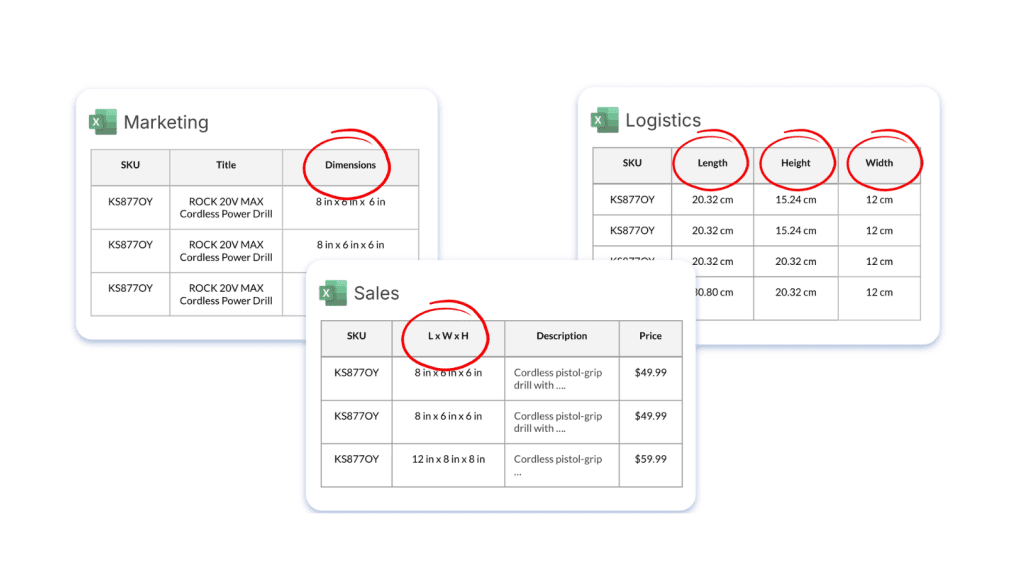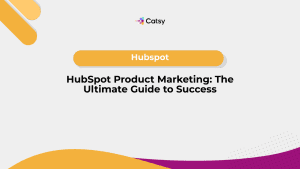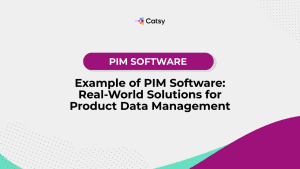The Importance of Accurate Product Information for B2B Sales Success

- Accurate product information is essential for B2B sales success.
- Managing product information in a B2B context is challenging due to data complexity, frequent updates, and multichannel distribution.
- Implementing robust PIM software ensures accuracy and consistency across all channels.
In this Article
Did you know that 48% of business-to-business (B2B) buyers consider finding up-to-date product information a top challenge? At the same time, 40% say that their main pain points during purchasing are shipping costs and inaccurate pricing. Should these figures scare you? Absolutely, especially if the statistics tell the story of your buyers. But why?
The CMO Council reports that 87% of B2B buyers rely on the product information available online to select vendors. This tells you that the information you share online has considerable sway on whether your products will find a buyer.
So, what happens when the prospect discovers a glaring discrepancy between the advertised features and the reality? Does this sound like a recipe for a lost sale? Absolutely. Trust and expertise are paramount in the world of B2B sales. This means that ensuring your product information is accurate and up-to-date is not a nicety but a critical factor for sales success. In this light, this blog post walks you through the importance of accurate product information and explores how it can empower your sales team to close more deals.

Product Information in B2B Sales
What is product information?
Product information is the data and details describing a product’s characteristics, features, and use. It encompasses everything from basic descriptions to detailed specifications, pricing, availability, and usage instructions. In other words, product information is the comprehensive repository of data that defines a product’s identity.
Product information is more complex and vital in the B2B environment than in the business-to-customer (B2C) environment. But how? To truly appreciate the unique nature of this data in the B2B context, let’s draw a comparison.
Comparing product information in B2B vs B2C
Imagine a consumer shopping for a cordless drill for home use. They might be concerned with basic specifications like battery life, weight, and perhaps a few critical features. The details they encounter are typically designed for quick consumption: bullet points highlighting main features, a handful of high-quality images, and perhaps some user reviews. This information is tailored for individual decision-making, often driven by personal preferences and immediate needs.
Now, contrast this with a B2B scenario where a construction company wants to purchase power tools in bulk for its workforce. The details required here are vastly more complex and nuanced. They go far beyond simple specifications into areas that can have far-reaching implications for the buying organization’s operations, safety protocols, and bottom line.
In this B2B context, product information must provide a detailed view of technical specifications. As such, it’s not enough to list basic capabilities; instead, it must offer granular details on torque ratings, impact energy, vibration control systems, and dust extraction capabilities. This level of detail is crucial because B2B buyers are often highly knowledgeable professionals who need to understand precisely how these tools will perform under various job site conditions.
Other information that this category of buyers may want to know includes in-depth performance metrics and benchmarks, the total cost of ownership, including maintenance and support, regulatory compliance and security certifications, customization possibilities, integration services, case studies of similar implementations, and detailed warranty and service level agreement information.
The key takeaways from this illustration are that product information in the B2B context is typically:
- More complex and detailed
- Focused on long-term value and integration
- Tailored to sophisticated buyers with technical knowledge
- Critical for multi-stakeholder decision-making processes
- Instrumental in justifying significant investments
How Product Information Influences Buying Decisions
One survey found that product information shapes B2B buying decisions. According to the study, 86% of respondents said details like product data sheets trigger their purchasing decisions. This suggests that detailed and accurate product data is crucial in decision-making. But the question is: how does this happen?
Product information builds trust and credibility.
Trust is the currency in any business environment, especially in successful B2B relationships. This means the number one priority for firms is to fashion themselves into an entity that others can rely on for quality products. Detailed and accurate product information is the building material for this trust.
The trust-building elements:
- Transparency in product descriptions. This includes things like:
- Providing clear, honest, and comprehensive information
- Disclosing both advantages and potential limitations
- Offering detailed technical specifications without ambiguity
- Using industry-standard metrics for performance claims
- Providing real-world usage scenarios and case studies
So, what does a transparent disclosure of product information look like? See this example of a power tools manufacturer showcasing industrial drills: “Our industrial drill has a maximum torque of 50 Nm, suitable for most construction tasks. However, for heavy-duty drilling in reinforced concrete, users may need our high-torque model.”
You wouldn’t be transparent if the details looked like this: “Our industrial drill is powerful enough for all your needs.”
- Honesty about both strengths and limitations
- Demonstration of deep understanding of buyer needs
Trust has a sizable impact on your business operations; see the illustration below:
High Trust → Long-term relationships → Repeat purchases
Low Trust → Hesitant buyers → Lost sales opportunities
Product information enables informed decision-making
B2B purchases typically involve significant investments with far-reaching implications. So, the odds are stacked against the individual willing to acquire a new item without proper information. Without sufficient product information, how will the purchasing officer ascertain that the new item aligns with their business objectives?
However, the probability of mistakes tends towards zero when the buyers have detailed information. How does detailed information aid decision-making?
- It allows for a thorough cost-benefit analysis
- It helps assess the impact on operations and productivity
- It facilitates an understanding of integration requirements
For example, when purchasing a power tool, performance data helps the buyer to assess the impact on project timelines, compatibility information helps to understand integration needs, and cost of ownership data allows them to evaluate the tool’s long-term value.
Product information facilitates efficient sales processes
Time is crucial in B2B sales. Any inaccuracies in product information will drag the sales process. Comprehensive product information streamlines the process by anticipating and answering buyer questions upfront.
When essential details are readily available, sellers enjoy several benefits, including:
- Reduces back-and-forth communication
- Speeds up the decision-making process
- Allows for more strategic discussions
Product information enhances customer experience and satisfaction
Product information’s influence extends beyond the point of sale, playing a crucial role in customer satisfaction and long-term success. With accurate and complete information, the seller achieves the following:
- Sets realistic expectations
- Enables effective product use
- Supports efficient after-sales service
We can look at this scenario from a different perspective. The illustration below shows a typical customer satisfaction cycle and how the seller affects the outcomes.
Accurate Information → Realistic Expectations
Clear Usage Guidelines → Effective Product Use
Comprehensive Support Data → Quick Issue Resolution
Positive Experience → Increased Satisfaction → Repeat Business

Challenges in Managing Product Information for B2B Businesses
While the importance of accurate product information is undeniable, managing it effectively presents several challenges. Some examples include:
1. Volume and complexity of product data
A typical B2B company has extensive product lines with complex details and variations. This creates a massive volume of data that needs to be managed. Each product might have numerous attributes, such as dimensions, materials, technical specifications, and compliance information.
For example, a company selling industrial machinery might need to document detailed technical specs, operational parameters, maintenance schedules, and safety guidelines for each model. This data’s sheer volume and complexity can overwhelm traditional data management systems, leading to potential errors and inefficiencies.
2. Multiple data sources and formats
B2B businesses often deal with product information from various sources, including suppliers, manufacturers, and internal departments. This information is stored in different formats and systems, creating segregated data storage locations.
For instance, a company might receive product specifications in PDF documents from suppliers, inventory data in spreadsheets from the warehouse, and marketing content in a content management system. This fragmentation can result in:
- Conflicting product details across different platforms
- Outdated information in some channels
- Inefficiencies in updating and maintaining data
Without a centralized system for product information management, fragmentation can persist. As a result, companies may be unable to ensure that all departments have access to up-to-date and accurate information.
3. Frequent updates and changes
Industrial products frequently undergo updates and modifications for many reasons, including technological advancements, changing market demands, and evolving regulations.
Consider a scenario where, each week, a different department takes an action that impacts product information. For example, see the timeline below:
Week 1: Engineering improves product efficiency
Week 2: Marketing updates product brochures
Week 3: Sales team informed of new specs
Week 4: Website updated with new information
This dynamic environment makes it challenging to keep product information updated. A lag in updates can lead to misinformation and potential customer dissatisfaction, so businesses need robust processes to effect the changes quickly.
4. Compliance with industry regulations and standards
Certain industries have specific rules and standards that product information needs to comply with. Failure to do so can result in legal repercussions and reputational damage.
Compliance challenges include keeping up with changing regulations across different markets, ensuring an accurate representation of compliance status, and providing detailed documentation for audits.
For example, a company producing professional-grade power tools must manage information on Occupational Safety and Health Administration (OSHA) compliance, Underwriters Laboratories (UL) certification, CE marking for European markets, Restriction of Hazardous Substances (RoHS) compliance, Ingress Protection (IP) ratings for dust and water resistance, noise emission levels (in decibels) as per EU regulations, vibration levels as per ISO standards, and country-specific electrical safety standards.
So, a single cordless drill might need to comply with:
- UL 60745-1 for hand-held motor-operated electric tools
- 2006/42/EC Machinery Directive for CE marking
- IEC 60529 for IP rating (e.g., IP54 for dust and water resistance)
- 2000/14/EC for noise emission in the environment
Failure to accurately manage this information can lead to legal issues and potential recalls, blocked sales in specific markets, damage to brand reputation, and lost sales opportunities due to the inability to prove compliance.
5. Managing Product Information Across Multiple Channels
A typical B2B seller utilizes various channels to reach customers. Some examples include company websites, e-commerce platforms, print catalogs, sales presentations, technical documentation, and third-party distributors.
Each channel may have different requirements for presenting product information, and ensuring cohesiveness is a considerable challenge. For example, the company website might allow for detailed product descriptions and technical specifications, while a third-party marketplace might require condensed information in a specific format. Maintaining consistency across all these platforms can be a logistical nightmare.
The Benefits of Accurate Product Information for B2B Sales
Product information’s substantial sway on purchase decisions in the B2B environment makes it a crucial aspect of business operations. Looking at this scenario from a different perspective tells us that product information offers many benefits when it meets buyers’ expectations. One way it does so is by adequately informing the buyers. So, what are some of these benefits?
1. Enhanced customer experience through transparency and clarity
Buyers can confidently make informed decisions When they have access to accurate and detailed product information. This transparency builds trust and enhances the overall customer experience.
For instance, a construction company looking to purchase high-performance angle grinders would appreciate detailed specifications on motor power, disc size, and variable speed settings. By providing this information upfront, along with clear use cases and limitations, the seller demonstrates a commitment to customer satisfaction.
2. Increased sales efficiency with well-informed buyers
Comprehensive product information allows buyers to come to sales conversations better prepared and with more specific questions. This preparation can significantly streamline the sales process.
For example, a buyer interested in a line of cordless impact drivers might review detailed torque specifications, battery life data, and weight information before contacting a sales representative. The subsequent conversation can then focus on how the tools fit the buyer’s needs rather than basic product education.
3. Improved conversion rates due to a clear value proposition
Accurate product information allows B2B sellers to communicate their products’ unique selling points. This can lead to higher conversion rates. When buyers can easily understand how a product meets their needs and outperforms competitors, they’re more likely to make a purchase.
For example, suppose a manufacturer highlights that their power tools are made with durable materials, offer superior performance, and include advanced safety features. In that case, buyers can quickly grasp the value and are more inclined to choose these tools over competitors’ offerings. So, accurate product information helps to effectively communicate these key selling points, turning prospects into customers.
4. Reduced customer churn due to product satisfaction
Accurate product information ensures customers know exactly what to expect from their purchase, leading to higher satisfaction and reduced churn. When a company’s products are described accurately, customers are less likely to encounter unpleasant product performance or suitability surprises.
For instance, a buyer purchasing a set of precision screwdrivers for electronics repair will have specific torque and size requirements. If the product matches the detailed specifications provided, the buyer will likely be satisfied and may become a repeat customer.
5. Reduced operational costs
Accurate product information can lead to significant cost savings in various operational areas. Businesses can see substantial improvements in their bottom line by reducing the need for extensive customer support, minimizing returns due to mismatched expectations, and streamlining inventory management.
For example, if a company sells industrial power tools through multiple channels (e.g., online store, distributors, and direct sales), having a centralized and accurate product information management system ensures that all channels have up-to-date information. This reduces the risk of miscommunication, returns due to incorrect orders, and time spent correcting errors.
Strategies for Ensuring Accurate Product Information
Having stressed the importance and benefits of accurate product information, it’s only fair that we explore the strategies for achieving it.
1. Implementing a product information management (PIM) system
A system is a lot of things, but generally, it is a way of working, organizing, or doing something that follows a fixed plan or set of rules. It can also refer to a set of interconnected elements that work together to create a unified whole.
The above paragraph is crucial because it helps explain a product information management (PIM) system. Accordingly, a PIM system is a set of interconnected elements—including product information, software tools, users, and processes—that form a unified whole. The system ensures that high-quality, accurate, and up-to-date product information is consistently available across all channels.
What is PIM software?
At the core of this system is PIM software. The software sits between inventory systems, such as spreadsheets of technical specifications and logistics details in the ERP system, and product information consumers. The consumers can be within the organization (i.e., sales and marketing departments) or outside the organization (i.e., distributors and buyers).
PIM software consolidates all relevant information into a repository that is accessible to authorized personnel from anywhere. Besides storing product data, the tool allows users to enrich the information, enhancing its accuracy and completeness. A tool like Catsy’s PIM allows users to add custom attributes to describe their products thoroughly.
A typical PIM solution, whether PIM for manufacturers or other use cases, stores product information in a single and accessible location. It often includes features for data validation, deduplication, and standardization, helping maintain product data’s accuracy and consistency. It also can integrate with other business systems like ERP, CRM, and e-commerce platforms, ensuring that any updates or changes made in one system are automatically reflected in others. Other essential features of a typical PIM software include workflow management, multichannel distribution of product information, and product data localization.
How PIM software helps to maintain accurate product information
As we’ve established, a PIM system acts as the central nervous system for your product information. But how exactly does the PIM software within this system ensure accuracy? Here are some key functionalities:
- Data validation and standardization: Imagine a scenario where the engineering department lists a product’s weight in kilograms while marketing uses pounds in their brochures. This inconsistency creates confusion. PIM software establishes data validation rules to ensure all weight entries are in kilograms or offers conversion tools to maintain consistency across channels.
- Data deduplication: Over time, duplicate product entries can creep into databases. PIM software identifies and eliminates these redundancies, ensuring a single source of truth for each product.
- Workflow management: PIM solutions can establish transparent processes for data entry, validation, and approval, ensuring that all product information undergoes appropriate checks before syndication.
- Data enrichment: Users can continuously improve the quality and completeness of product information by adding new attributes, updating existing ones, or enhancing product descriptions.
2. Establishing data governance policies
Even the most robust PIM software cannot circumvent the challenges of a disorganized data management system. As such, part of the foundation must incorporate data governance policies. These policies define how data should be created, stored, updated, and used across the organization.
Critical aspects of data governance for product information include:
- Defining roles and responsibilities for data management
- Establishing data entry and updating procedures
- Setting standards for data quality and completeness
- Creating guidelines for data security and access control
For example, a power tool manufacturer might implement a policy requiring the engineering department to verify all product specifications before they are entered into the system. This ensures that technical data is accurate and up-to-date.
3. Regular data quality checks and cleaning
Even with the best processes, inaccuracies can creep in over time, necessitating regular data quality checks. These checks involve reviewing product information for inconsistencies, missing details, or outdated specifications. Most robust PIM solutions have built-in data quality checks, but manual reviews are crucial to catch discrepancies.
4. Collaborating with suppliers
Manufacturers often rely on suppliers for component information. Therefore, all parties must always be transparent regarding what details pass from one end to the other. This calls for robust collaboration strategies, some of which may include:
- Establishing clear communication channels for product updates
- Implementing shared data standards and formats
- Regular meetings or digital touchpoints to discuss product changes
Conclusion
Accurate product information is the foundation of successful B2B sales strategies. Without it, even the best sales approaches will fall short.
However, managing product information is inherently complex for manufacturers and other B2B businesses for many reasons, including data volume and constant update needs. As such, this process is prone to errors and inefficiencies if companies fail to adopt robust PIM software.
Therefore, implementing a comprehensive PIM system centered on powerful PIM software is not just beneficial; it’s essential. The system allows B2B companies to ensure the accuracy and consistency of their product information, laying a solid foundation for sales success in today’s competitive marketplace.
Product information management in B2B contexts is generally more complex and detailed than in B2C. B2B products often have more technical specifications, customization options, and compliance requirements. For example, a power tool manufacturer selling to businesses must provide in-depth technical data, compatibility information, and industry-specific certifications. In contrast, B2C product information typically focuses on more basic features and benefits that appeal to individual consumers. B2B also often involves managing information for a broader range of stakeholders, from engineers to procurement specialists, each requiring different levels of detail.
In B2B sales, complex purchases often involve multiple stakeholders and significant investments. Access to accurate and comprehensive product information empowers buyers to conduct thorough research, compare solutions, and make informed decisions aligned with their business needs. This reduces confusion, builds trust, and ultimately leads to higher conversion rates and increased sales success.
A PIM system centralizes product information, ensuring consistency across various sales channels. When product data is updated in the PIM, these changes are automatically reflected across all connected channels, whether an e-commerce website or a sales representative’s mobile app. This eliminates the need for manual updates in multiple places, reducing the risk of errors and inconsistencies.
When choosing a PIM software solution, B2B businesses should look for features such as data validation and standardization, data enrichment, multichannel distribution, workflow management, and integration with other business systems. They should also consider factors such as ease of use, scalability, customization options, vendor reputation, and support. Ultimately, the PIM software solution should be tailored to the specific needs and goals of the business.
Accurate product information can significantly impact a company’s bottom line. Firstly, it reduces operational costs by minimizing returns due to mismatched expectations and decreasing the burden on customer support teams. For example, when customers can access detailed, accurate information about an industrial vacuum cleaner, they’re less likely to make an unsuitable purchase or need extensive post-sale support. Secondly, it improves conversion rates by giving potential buyers the confidence to make informed decisions, potentially shortening the sales cycle. Lastly, accurate information enhances customer satisfaction and loyalty, leading to repeat business and positive word-of-mouth recommendations. This is particularly valuable in B2B contexts where relationships are often long-term and high-value.




